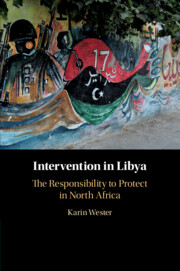Book contents
- Intervention in Libya
- Intervention in Libya
- Copyright page
- Dedication
- Epigraph
- Contents
- Preface
- Maps
- Introduction
- 1 The Origin of the Responsibility to Protect
- 2 Authority Based on Protection in a Historical Context
- 3 Libya and the Era of Qadhafi’s Rule
- 4 The Libyan Uprising and the International Response, February 15–26, 2011
- 5 The Libyan Uprising and the International Response, February 26–March 17, 2011
- 6 Operation Odyssey Dawn
- 7 Operation Unified Protector, NATO, and the UN
- 8 A Divided International Community Confronts a Divided Libya
- 9 Lessons to Be Learned
- Epilogue
- Select Bibliography
- Index
8 - A Divided International Community Confronts a Divided Libya
Published online by Cambridge University Press: 28 February 2020
- Intervention in Libya
- Intervention in Libya
- Copyright page
- Dedication
- Epigraph
- Contents
- Preface
- Maps
- Introduction
- 1 The Origin of the Responsibility to Protect
- 2 Authority Based on Protection in a Historical Context
- 3 Libya and the Era of Qadhafi’s Rule
- 4 The Libyan Uprising and the International Response, February 15–26, 2011
- 5 The Libyan Uprising and the International Response, February 26–March 17, 2011
- 6 Operation Odyssey Dawn
- 7 Operation Unified Protector, NATO, and the UN
- 8 A Divided International Community Confronts a Divided Libya
- 9 Lessons to Be Learned
- Epilogue
- Select Bibliography
- Index
Summary
This chapter first examines the positions of the local actors in the evolving conflict in Libya: the Qadafi regime and its forces on the one hand; and the Transitional National Council and the opposition forces on the other. The second part assesses the role of a wide range of international actors – other than NATO – who were involved in addressing the Libyan crisis between March and October 2011. These actors – including the UN, the Libya Contact Group, regional organizations, and individual states – also claimed to have the authority to act on behalf of the international community. A number of them, while being highly critical of NATO’s implementation of resolution 1973, advocated an entirely different course of action vis-à-vis Libya, focused on brokering a political settlement to the conflict. Finally, the chapter examines the convergence of international views emerging towards the end of the conflict. It also assesses the decision-making process leading to the establishment of the United Nations Support Mission in Libya (UNSMIL), and to the termination of the Security Council mandate provided for in resolution 1973 – which effectively transferred the responsibility to protect back to Libya’s national authorities.
Keywords
- Type
- Chapter
- Information
- Intervention in LibyaThe Responsibility to Protect in North Africa, pp. 252 - 289Publisher: Cambridge University PressPrint publication year: 2020

